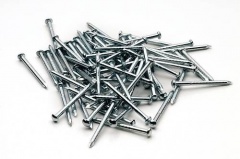Nails
| Infobox on Nails | |
|---|---|
| Example of Nails |  |
| Facts | |
| Origin | - |
| Stowage factor (in m3/t) | 0,71 m3/t (bags) / 0,99 m3/t (kegs) |
| Humidity / moisture | - |
| Ventilation | - |
| Risk factors | See text |
Nails
Description
In woodworking and construction, a nail is a pin-shaped, object of metal (or wood called a treenail) used as a fastener, peg to hang something, or sometimes a decoration. Generally nails have a point on one end and a head on the other. Formerly wrought iron, today's nails are typically made of steel, often dipped or coated to prevent corrosion in harsh conditions or improve adhesion. Ordinary nails for wood are usually of a soft, low-carbon or "mild" steel (about 0.1% carbon, the rest iron and perhaps a trace of silicon or manganese). Nails for concrete are harder, with 0.5-0.75% carbon.
Nails are typically driven into the workpiece by a hammer, a pneumatic nail gun, or a small explosive charge or primer. A nail holds materials together by friction in the axial direction and shear strength laterally. The point of the nail is also sometimes bent over or clinched after driving to prevent falling out.
Nails are made in a great variety of forms for specialized purposes. The most common is a wire nail. Other types of nails include pins, tacks, brads, and spikes.
Shipment / Storage / Risk factors
Shipped in cases, bags or kegs.
Subject to damage by rusting, which may be due to the nature of the packing, or dampness inherent in the wood from which cases are made. Customary method of cleaning is by sand-blasting.











